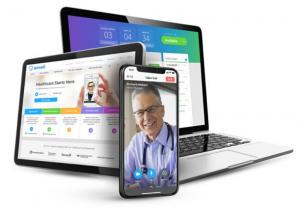Google-backed American Well Corp, also known as Amwell, is one of many digital platforms that helps patients virtually connect with their providers. The current global health crisis sent the telehealth industry fast-tracking its offerings this year, as the COVID-19 virus forced millions of people to stay at home.
Since its launch in 2006, Amwell has enabled over 5.6 million telehealth visits. This early player in virtual appointments saw more than half of those visits just within the past six months. Like many telehealth companies, the coronavirus boosted business for them in a big way—in April, Amwell saw more than 40,000 visits per day, a massive jump from the 2,900 daily visits in 2019.
Its recent success prompted the company to go public in a highly anticipated IPO. The IPO went from $18 to $25 a share, a nearly 40% increase in its first day of trading. This August, Google provided Amwell with $100 million in return for agreeing to utilize Google Cloud for the platform’s video capabilities. After the IPO, Google owned 3.03% of the company’s common stock. The IPO’s underwriters include Goldman Sachs, Piper Sandler, and Morgan Stanley.
Over 150 healthcare systems use Amwell’s solutions, including big names like Northwell Health and New York-Presbyterian. Customers also include 55 health insurers, such as Anthem and several under the Blue Cross Blue Shield umbrella. Many major companies also utilize Amwell as part of their employees’ coverage, including the Campbell Soup Company and Wellpath. All told, Amwell covers over 80 million individuals.
The Boston-based company was founded by brothers Ido and Roy Schoenberg, who serve as Amwell’s Co-CEOs. Ido, the older of the two brothers, is also Amwell’s Chairman, and Roy is the company’s President. Ido said in a statement that they plan to use a large portion of the IPO proceeds to, “continue to innovate on an accelerated basis.”
The Schoenbergs also have their eye on acquiring tech companies both domestically and internationally, to help expand their reach. The duo hopes to create a platform accessible from any country around the world, and especially in rural or underserved communities where people do not have reliable access to healthcare.























